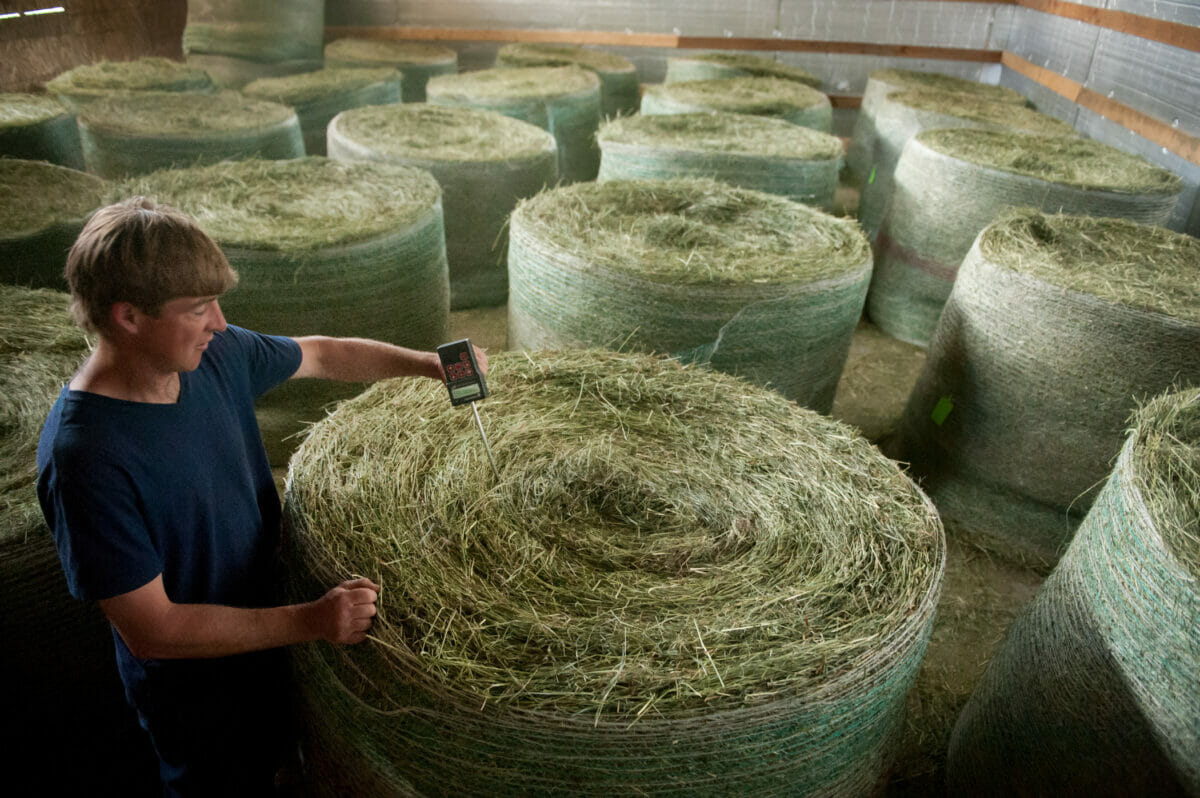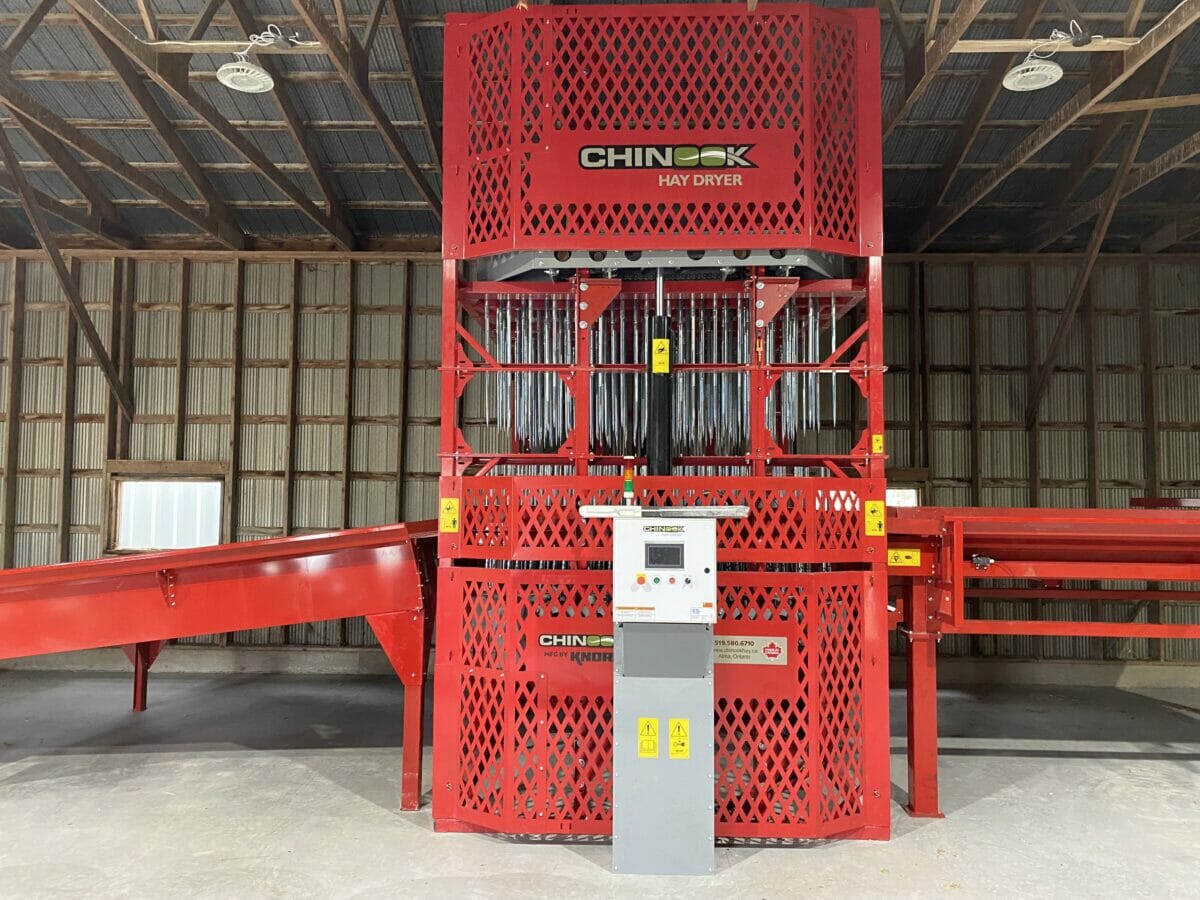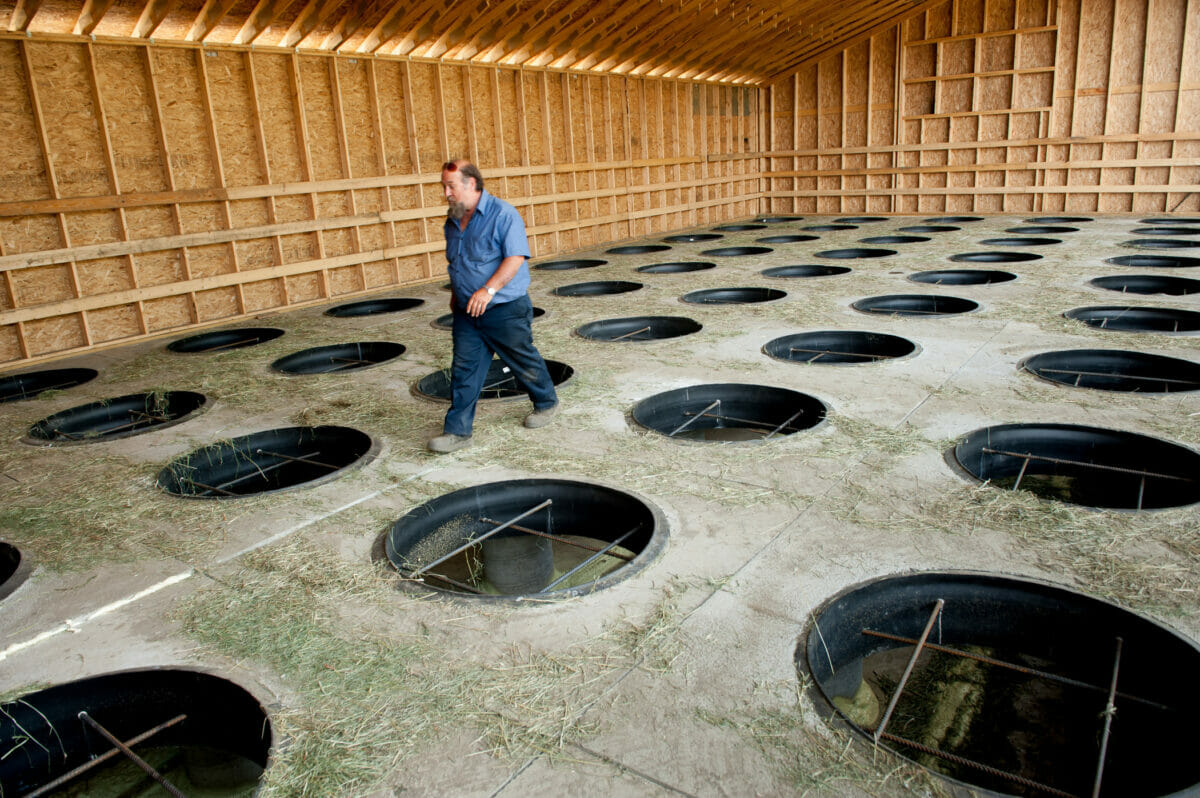The Future of Hay Drying in America
Although hay dryers are a staple throughout Europe, they are few and far between on US farms. But as climate change intensifies, that’s changing.
The Future of Hay Drying in America
Although hay dryers are a staple throughout Europe, they are few and far between on US farms. But as climate change intensifies, that’s changing.

At Jasper Hill Farm in Vermont, the hay dryer is part of injecting European tradition into American cheesemaking. courtesy of Jasper Hill Farm.
Nestled along the banks of the Portage River in Pemberville, Ohio, John Russell has spent more than 20 years working as a commercial hay producer. From a season that typically spans May through October, he has long relied on an arsenal of hay bines, conditioning rolls, rakes and tedders to produce 500 to 600 acres of dry hay each year. He has also made regular upgrades to drainage lines on his farm to ensure his crop is as dry as possible before being sold and pitched into bundles.
In recent years, however, unpredictable weather patterns and relentless rain have repeatedly left his fields saturated, putting him at risk of falling weeks behind in hay production. Russell says his usual equipment wasn’t cutting it anymore, so last winter in 2020, he decided to buy a hay dryer.
“I’ve always thought of [hay dryers] as a last resort, but I really felt like we had been doing all that we could,” he says. “This will get you out of a bind, when the forecast changes if you think you’re going to lose a day. It will allow you to beat the rain.”
His machine consists of a metal chamber that houses 63 hay bales at their individual sizes of 14x18x36 inches. In the drying cavity, each bale is punctured with spikes that shoot out hot air. According to Russell, it has the ability to dry them in 15 to 20 minutes. That’s way faster than drying out only in the field, which can take anywhere from one to five days depending on the sun and environmental conditions.

His machine, which he purchased in Canada, was about $225,000. In general, they carry a price tag of around $220,000 to $300,000 depending on the manufacturer, but Russell figures he’s been able to earn back his investment by speeding up production and moving through the blips in weather.
Despite making a case for hay dryers’ effectiveness, the Ohio farmer is only part of a handful of producers across the country using the machines. It’s a stark contrast to Europe, where they’re considered a widespread fixture in the world of haymaking and feed production, specifically on dairy farms.
Experts in agriculture claim the disparity comes down to affordability and differing attitudes around food. European farmers are subsidized by the EU, which provides around $65 billion each year to support farmers during turbulent years, possibly making it easier for them to offset the costs of a hay dryer. But with climate change already affecting various aspects of agriculture, experts believe there’s potential for the technology to gain popularity in other countries, including the US.
Joe Lawrence, a forage systems specialist at Cornell University’s College of Agriculture and Life Sciences, says he’s only seen larger commercial hay producers invest in hay dryers because it’s typically not financially feasible, especially for smaller operations.
“Any time I’ve talked to a US producer that has considered [hay dryers] or tried, I’m hearing it’s a very energy-intensive process,” he says. “Some of these things have large diesel engines and, if you have to pay the market rates for energy, whether it’s electricity or natural gas or whatever your source is, it’s going to add quite a bit of cost unless you can get a pretty substantial return.”
But for farmers grappling with weather changes in their region, Lawrence doesn’t rule out the possibility of increased demand for dryers. He forecasts a future where unpredictable and more severe weather will be of greater inconvenience, but he says he could also see some producers switching to silage to cope.
Those embedded in the European market argue that the cost of the machines is offset by the fact that you’re producing a higher-quality product with them. Sabine Zastrow’s family has been manufacturing hay dryers since the 1970s for farms across the EU. Currently, under its Germany-based company AgriCompact Technologies, the family has more than 1,000 customers in Europe but only two in the United States. She believes the lack of machines in the US comes down to there not being as many producers who subscribe to the Slow Food movement, which promotes local food cultures and traditions, or understand the benefit of dry hay feed without preservatives.
“In Europe, we have and live by the philosophy of ‘you are what you eat.’ If the animal is not fed or treated well, how can you, as a human being, be well fed?” she says. “The animals and what you feed them, it’s all connected, like a circle—it comes back around for you. The food tastes better because the animals are happy and healthy.”
Zastrow notes that in the EU there’s been a history of banning additives in animal feed throughout the agriculture sector and some name protection regulations for European cheeses, such as Parmigiano-Reggiano, prohibit fermented feeds. In a nutshell, she says, a diet of dry hay without preservatives is thought of as the healthiest type of forage and a clear indicator of a top-quality product, especially when the milk is unpasteurized.
In comparison to silage diets and distillers grains, studies have pointed to dry hay’s potential to reduce the presence of harmful bacteria, such as listeria, in raw milk. So the hay dryers not only help producers keep up with Europe’s demand for dry hay, but they also help eliminate moisture where mold and other bacteria can put an animal’s—and potentially a human’s—health at risk.
This is a philosophy to which Jasper Hill Farm also subscribes. The dairy farm and creamery in Greensboro, Vermont feeds its cows a dry hay diet with corn and grain that is free of GMOs and ferments. In 2015, after visiting a number of producers in Europe to understand regional processes around making artisan cheese with raw milk, Jasper Hill installed its hay dryer. Its model differs to Russell’s in design. It consists of a floor with holes for 50 bales in which to sit. Under the floor, there’s a vacuum of space where an adjacent furnace powers up turbines that blow 104-degree air up through the bales over several hours.

The farm’s crop manager, Ellie Searles, says the dryer ensures the animals a clean, dry hay diet, making it possible for Jasper Hill’s cheeses to compete with the quality of various European alpine cheeses that have historically been celebrated.
“You have even more control over the microbial profile of the cheese, which can make or break taste, texture, quality and appearance,” she says, adding that the microbial content of the cheese is regularly screened. “You’re able to take the extra step to eliminate moisture and bacteria that could be harmful for the animals and consumers, but don’t risk complicating the microbial environment of the cellars where we store a lot of inventory.”
Like Russell, she’s noticed the machines have become an important management tool as farmers grapple with heavy waves of humidity due to recent wildfires and hurricanes, in addition to the regular rain patterns that start and cap off the haying season in Vermont. She believes hay dryers could become an important part of farms’ futures, including those that operate outside the specialty cheese market.
Russell, meanwhile, knows that he’s fortunate to be in the position where he can afford a hay dryer. But in order for these machines to become more popular, there needs to be a variety of models for small and big producers at a price that is reasonable because, he says, at the end of the day, the first priority is knowing you are able to make ends meet.
Follow us
This work is licensed under a Creative Commons Attribution-NoDerivatives 4.0 International License.
Want to republish a Modern Farmer story?
We are happy for Modern Farmer stories to be shared, and encourage you to republish our articles for your audience. When doing so, we ask that you follow these guidelines:
Please credit us and our writers
For the author byline, please use “Author Name, Modern Farmer.” At the top of our stories, if on the web, please include this text and link: “This story was originally published by Modern Farmer.”
Please make sure to include a link back to either our home page or the article URL.
At the bottom of the story, please include the following text:
“Modern Farmer is a nonprofit initiative dedicated to raising awareness and catalyzing action at the intersection of food, agriculture, and society. Read more at <link>Modern Farmer</link>.”
Use our widget
We’d like to be able to track our stories, so we ask that if you republish our content, you do so using our widget (located on the left hand side of the article). The HTML code has a built-in tracker that tells us the data and domain where the story was published, as well as view counts.
Check the image requirements
It’s your responsibility to confirm you're licensed to republish images in our articles. Some images, such as those from commercial providers, don't allow their images to be republished without permission or payment. Copyright terms are generally listed in the image caption and attribution. You are welcome to omit our images or substitute with your own. Charts and interactive graphics follow the same rules.
Don’t change too much. Or, ask us first.
Articles must be republished in their entirety. It’s okay to change references to time (“today” to “yesterday”) or location (“Iowa City, IA” to “here”). But please keep everything else the same.
If you feel strongly that a more material edit needs to be made, get in touch with us at [email protected]. We’re happy to discuss it with the original author, but we must have prior approval for changes before publication.
Special cases
Extracts. You may run the first few lines or paragraphs of the article and then say: “Read the full article at Modern Farmer” with a link back to the original article.
Quotes. You may quote authors provided you include a link back to the article URL.
Translations. These require writer approval. To inquire about translation of a Modern Farmer article, contact us at [email protected]
Signed consent / copyright release forms. These are not required, provided you are following these guidelines.
Print. Articles can be republished in print under these same rules, with the exception that you do not need to include the links.
Tag us
When sharing the story on social media, please tag us using the following: - Twitter (@ModFarm) - Facebook (@ModernFarmerMedia) - Instagram (@modfarm)
Use our content respectfully
Modern Farmer is a nonprofit and as such we share our content for free and in good faith in order to reach new audiences. Respectfully,
No selling ads against our stories. It’s okay to put our stories on pages with ads.
Don’t republish our material wholesale, or automatically; you need to select stories to be republished individually.
You have no rights to sell, license, syndicate, or otherwise represent yourself as the authorized owner of our material to any third parties. This means that you cannot actively publish or submit our work for syndication to third party platforms or apps like Apple News or Google News. We understand that publishers cannot fully control when certain third parties automatically summarize or crawl content from publishers’ own sites.
Keep in touch
We want to hear from you if you love Modern Farmer content, have a collaboration idea, or anything else to share. As a nonprofit outlet, we work in service of our community and are always open to comments, feedback, and ideas. Contact us at [email protected].by Lindsay Campbell, Modern Farmer
October 18, 2021
Modern Farmer Weekly
Solutions Hub
Innovations, ideas and inspiration. Actionable solutions for a resilient food system.
ExploreExplore other topics
Share With Us
We want to hear from Modern Farmer readers who have thoughtful commentary, actionable solutions, or helpful ideas to share.
SubmitNecessary cookies are absolutely essential for the website to function properly. This category only includes cookies that ensures basic functionalities and security features of the website. These cookies do not store any personal information.
Any cookies that may not be particularly necessary for the website to function and are used specifically to collect user personal data via analytics, ads, other embedded contents are termed as non-necessary cookies.
Hay dryers are out of keeping with the Slow Food philosophy if they require the use of fossil fuels. Where frequent rains keep hay from drying naturally, perhaps it would be better to improve the method of making silage?
Out here in dry Utah, Staheli West makes hay steamers in order to keep the moisture content consistent.
Hay drying seems like something that could be accomplished using solar thermal and/or the “waste” heat from making biochar. Some electricity might be needed to move the hot air, but far less than other wise. Photovoltaics or generators fueled with charcoal gasification could eliminate all fossil fuel use from the process. The heat from the generator exhaust could be captured for drying. The solar hay drying system could also dry woodchips for making charcoal. The char could be added to the soil, live stock feed, and bedding, as well as fueling generators. The process heat produced during the char making… Read more »
In the third paragraph from the end, ““You’re able to take the extra step to eliminate moisture and bacteria that could be harmful for the animals and consumers, but risk complicating the microbial environment of the cellars where we store a lot of inventory.”
Is Searles providing a negative aspect of the dryer? It isn’t clear.
So as a horse owner how much does the dryer and cost of fuel to dry the hay increase the cost of a bale of hay? I know that will be passed on to the consumer… Cost of Hay has steadily increased over the years. Excusses given have been cost of fuel, fertilizer, drought, etc. But even in a good year it never goes back down…
Dryers would be useless in Colorado. Most days even with a light rain it’s dry enough to put hay up in three days. Very seldom is there a issue other than it getting to dry and then you loose all the leaf depending on what your putting up.
Nice concept, but the price and price of energy may remain an issue. Noticed all the bales were big and round. We had only the small squarish bales, easier to handle and stack without machinery. Would also say the conditions in Vermont aren’t the same nationwide. Bet alfalfa dries quickly outside in the Midwest or the Southwest.
My ranch
Do you think a large clear span hoop house could be a more affordable alternative, yes slower, but no fossil fuels needed ?
How does comparison to the cost of the Heil dryers of the 1060s. Cost of operation?